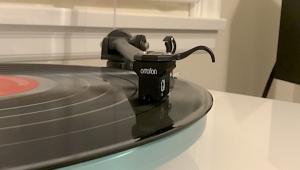AudioQuest 7000 Fe5 MC phono cartridge
I never went to dental school, but I used to be friendly with a bunch of dental students. They always had the best parties: Everyone would gather around the nitrous oxide canister and laugh their asses off until they'd drop from oxygen deprivation. (CES is kind of like that, if you've never been to one.)
Anyway, one of the first things you learn as an audio reviewer is never to say you don't hear a difference when you are expected to. To say otherwise is to risk being accused by your peers of losing your hearing: "Can you believe it? Fremer couldn't hear the difference between the Ubangi discs and the Ubetchi discs under his Edible Delusions preamp!!! His hearing's gone!"
I make reviewing life more difficult for myself by contrasting two pricey phono cartridges—the AudioQuest 7000 Fe5 costs $2550, the Lyra Clavis Da Capo costs $1895—in one review. While the two designs do sound different, they share a common heritage in Scan-Tech designer Jonathan Carr, and both are hand-built and tuned in Japan by Yoshinori Mishima.
So, in reading this review, please bear in mind that, while I will put a magnifying glass up to the differences between the two, they sound closer in character to each other than either does to cartridges from Dynavector, van den Hul, or Benz, for example.
Whether or not you think he's succeeded, Jonathan Carr has always tried to build resonances out of, and neutrality into, his designs. Each Scan-Tech design change has been undertaken with the idea of adding rigidity and mechanical integrity. The idea of "tuning" cartridges for different kinds of music, as some designers apparently do, is not part of Carr's game plan. "A resonance is a resonance," he told me at HI-FI '95, held last April in Los Angeles.
Yet all designers are faced with choices: of materials, and of structures. Ultimately you are hearing someone's sonic tastes: in the case of the Da Capo, Carr's and those of his cohorts; in the case of the Fe5, those of AudioQuest's Bill Low.
The Clavis Da Capo is a totally new design, not an upgrade or update of the original Lyra Clavis; the 7000 Fe5 is a totally redesigned replacement for AudioQuest's very popular 7000 and 7000 nsx cartridges.
So what's particularly fascinating about this comparison is, we're contrasting a cartridge engineered and built to designer Carr's specifications and tastes, with one fabricated by him to accommodate those of Bill Low.
I spoke with both Jonathan Carr and Bill Low about cartridge design choices and tradeoffs, sonic expectations, and consumer demands. When I was finished I came to a singular conclusion: What's amazing is not that there are outstanding sounding $2000 cartridges, but that there are good-sounding $200 ones (and there are).
A cartridge is essentially a precision-made, subminiature electrical generator. As in a generator, there is a coil, generally mounted on an iron armature/core, and a gap in a magnet/pole-piece assembly in which the coil/core assembly is centered. Movement of the coil in that gap, due to groove undulations, generates a minute electrical signal which is carried via microscopically thin wires to the output pins. A cartridge is essentially the inverse of a moving-coil loudspeaker.
The differences in sound you hear among cartridges are determined by the choice of diamond stylus shape; the cantilever material and its length and diameter; the core and coil materials and their configuration; the magnet material and its physical configuration; the choice of suspension material and its tuning; the damping material; and the body construction.
Most cartridges consist of three basic subassemblies: the diamond tip/cantilever/coil/core/suspension wire/stopper pipe; the magnet/pole-piece assembly; and the body. There are, however, many variations on the theme, and here we'll be whistling Scan-Tech's basic tune. But keep in mind that the Clavis Da Capo's design differs radically both from that of the basic model and from the Fe5's, in ways which will be discussed later on.
Let's look at the subassemblies one at a time. The cantilever can be solid or hollow, and can be fabricated from a variety of materials. The AudioQuest Fe5 uses a solid boron cantilever, the Lyra Da Capo, a "Ceralloy" composite cantilever. (Ceralloy is a metal reinforced with ceramic "whiskers," which Carr tells me are stronger than carbon fiber.)
Why boron? Why Ceralloy? These are designer choices—each yields a different sound. In designing the Fe5 to his liking, Low received samples of various configurations of materials from Scan-Tech and made choices based upon listening and other considerations we'll get into later.
- Log in or register to post comments



















































